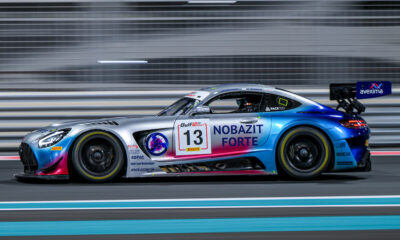SRO Motorsports Group is embarking on an overhaul of its driver categorization system for Fanatec GT World Challenge Europe powered by AWS, which will see faster young drivers with karting and single-seater racing backgrounds assigned to Gold status.
A new set of criteria (listed below) will be rolled out to define each rating, in a move that is set to shift the categorization of many competitors in the GTWC Europe paddock.
Fast drivers in the amateur-focused Bronze tier will become Silver while quick Silver drivers, who are often young prospects fresh out of single-seaters, will be moved to Gold.
Current Golds will merge into the top Platinum rung of the driver rating ladder.
The new approach will aim to “correct the system” in the eyes of SRO founder and CEO Stephane Ratel by taking the Silver categorization back to its roots of being reserved for fast amateurs and young drivers who lack a substantial early racing background.
The category is currently a favored place for new talents to establish themselves in GT racing before going on to compete at higher levels.
Ratel said during last weekend’s Endurance Cup season finale at Barcelona that the new range of criteria has been put forward to the FIA for approval ahead of the 2023 season, however GTWC Europe is set to introduce its own version next year in the meantime.
“We have embarked into a revision of the driver categorization system, which has suffered the last number of years,” said Ratel.
“We created the driver categorization system when we introduced the GT3 European championship back in 2006. At the time, it was an amateurs’ championship.
“Your Bronze drivers were real gentleman drivers, and the Silver drivers were the young drivers. But the young drivers were very often the sons of the gentleman drivers.
“Almost all of them didn’t have any karting or single-seater experience. They were coming into racing [through] GTs.
“But progressively, this became more and more professional. At the end, we have two classes – Gold and Platinum – for the same type of drivers. To see the difference between a Pro which is Platinum and a Pro which is Gold, there is basically no difference.
“Behind these two classes which are under-represented, you have a very large class of the Silver drivers. In any sport, if you start skiing or tennis when you are six years old, or if you start when you’re 20 years old, you’re not going to be at the same level.
“It’s about time that we divide the Silver class between one class into Silver for the Silvers of the beginning – who are the very, very good gentleman drivers – and the young drivers who come to GT with very little prior experience.
“Gold becomes the category for all the young drivers that have started racing when they were young, that have gone through the ranks of karting and single-seaters and arrive in GT with a view to become professional.”
Ratel suggested that SRO will resort to upgrading driver categorizations if the FIA does not approve of the proposed changes.
Drivers are set to have the right to appeal if they disagree with their new rating, while GTWC Europe will implement a committee consisting of representatives from seven teams.
“Ten or 15 years ago, no young drivers wanted to become a GT racing driver,” Ratel said.
“They wanted to do single-seaters and prototypes, and they were not thinking of GT racing. So it’s about time that we correct the system.
“All the fast Bronze drivers have to become Silver. All the fast Silver drivers have to become Gold, and all the Gold drivers have to be Platinum.
“That is the proposition that we have put forward to the FIA.”
Gold Cup Class Established for 2022
GTWC Europe has also introduced a new ‘Gold Cup’ category for next year, in an attempt to address the problem of drivers having their rating status derogated to fit into a class.
Gold Cup crews will consist of one Platinum or Gold, one Silver and one Bronze. The move brings the series back to four categories after Am Cup disappeared this season.
The new class is designed to avoid downgrading Silver drivers to Bronze status in order to make the double Bronze driver requirement for the Pro-Am class.
This move was carried out in the 2021 Endurance Cup by Bentley outfit CMR, which started the campaign in Pro-Am with Stuart White derogated to Bronze status, before moving to Silver Cup with White classified as a Silver alongside Bronze-rated Gilles Vannelet and a derogated Nelson Panciatici, whose usual status is Gold.
Pierre-Alexandre Jean replaced Panciatici in CMR’s lineup for the final two rounds.
Furthermore, RAM Racing’s Sam de Haan and GetSpeed’s Olivier Grotz, who are Silver-rated by the FIA, spent the season as Bronze* drivers in the Pro-Am ranks.
Pro-Am will maintain its established structure of two Bronzes teaming up with a professional driver going forward.
“The Am class is going to be replaced by the Gold Cup,” said Ratel.
“It is for a combination of a Pro driver, a Silver driver and a Bronze driver. That should avoid the requests for derogations we have had all along, and which have been really tiring for the championship.”
Additionally, the Pro class in GTWC Europe Sprint Cup is set to be limited to one Platinum driver pairing with a Gold or a Silver, after previously allowing two together.
“This is already the case for most teams, so it would just be a case of making it official,” Ratel said.





























